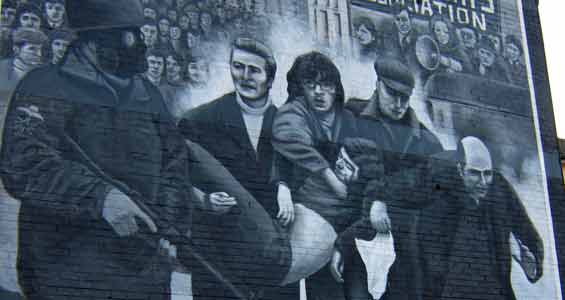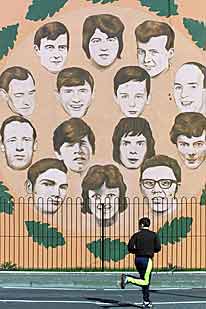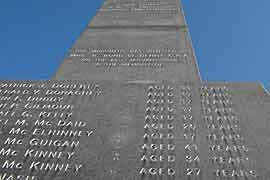Relatives seek Bloody Sunday truth
Families of protesters killed in Londonderry in 1972 hope new report will bring answers.

 |
| January 30, 1972, became known as Bloody Sunday |
When Mickey Bridge closes his eyes, he can still see the scene, hear the bullets, and remember the screams.
He points, past the houses that have sprung up over the last 38 years; there is a slight grimace on his face, as if it happened that morning.
“The soldiers, the lieutenant that actually shot me was standing [at the] back of the wall that was there, there were three or four in front of him when he fired,” he says.
Mickey was participating in a civil rights march in Londonderry on Sunday, January 30, 1972, when thousands of protesters took to the streets demanding equal rights for Catholics in Northern Ireland.
Claiming they had been shot at, British paratroopers opened fire on the demonstrators.
By the time the shooting ended, 13 protesters lay dead. One man later died from his injuries in hospital.
The area where the killings happened, the Bogside, became famous around the world, and the day became known as Bloody Sunday.
Shock and disbelief
Mickey rarely talks about what happened or how his friends and neighbours were killed, but says he relives those events every day.
 |
| Fourteen people were left dead following Bloody Sunday [AP] |
He was shot in the leg, one of 14 people wounded.
Even in the bright early spring sunshine, he still sees that grey day on the Bogside: “I don’t think anyone could visualise any solider going out and shooting into a crowd of people.
“You know, you could see it happening. You didn’t believe it. But it was there. It was reality.”
The British government of the time set up an inquiry to look into the killings. It reported its findings just 11 weeks later.
Conducted by Chief Justice John Widgery, it concluded that shots had been fired at the soldiers before they started shooting back.
It reported that for the most part the soldiers acted the way they did because they thought their orders allowed it.
And, it said, that while there was no proof any of the dead had been shot while handling a gun or a bomb, there was a “strong suspicion” they had done so during the afternoon.
But there were a number of glaring flaws in the report and it was widely dismissed as a whitewash.
Fresh inquiry
The families of the dead demanded a fresh inquiry. In January 1998, Tony Blair, the then British prime minister, gave the go-ahead.
Headed by Mark Saville, a UK judge, it had powers to subpoena witnesses and to order the disclosure of documents; the findings would then be made public.
Three months later, in Londonderry’s historic and ornate Guild Hall, the Saville Inquiry began.
Over the course of seven years, the inquiry heard from 921 witnesses at hearings in Northern Ireland and London.
The soldiers involved gave their version of events from behind screens to protect their identities, and the inquiry also received 555 written statements.
Saville has taken five years to assess the evidence and write his report.
His findings, due to be presented on June 15, are believed to comprise some 5,000 pages.
And the cost of the most expensive legal hearing in British history? It will easily top $300mn.
Chilling screams
Meanwhile, on the Bogside, a museum which charts the history of the area has been constructed. It includes a large section dedicated to the events of Bloody Sunday.
Over loudspeakers, a recording of the day is played – it turns from a lively, almost light-hearted parade to a series of chilling screams and cries.
Behind one glass case there is a white handkerchief. It belonged to Edward Daly, a Catholic priest, and became one of the most iconic images of the day.
The pictures of the balding clergyman, slightly stooped, waving his handkerchief in front of soldiers as a wounded man was half-carried, half-dragged from the scene, were beamed around the world.
On display as well are the baby clothes which were used to staunch the blood of 17-year-old Michael Kelly as he lay dying. They are dirty and old, and the blood stain has faded from crimson red to light brown.
John Kelly is the education officer in the museum and every day he sees the photograph of people working frantically, trying to save his brother’s life.
He had led the campaign for the new inquiry and dismisses any criticism of the cost: “To us it doesn’t matter. I see my brother’s life as being precious.
“And you couldn’t put a price on his life or any of the others who died that day. And you can’t put a price on truth. And you can’t put a price on justice,” he says.
Defining moment
Bloody Sunday was a defining moment in Northern Ireland’s Troubles, the common name used to describe its 35 years of sectarian violence.
 |
| A monument in Bogside commemorates those killed in the shootings on January 30, 1972 |
It drove many young Catholic men into the Irish Republican Army, strengthening an organisation which previously had little widespread support.
Eamonn McCann was on the march, and over the years as a journalist and a broadcaster, he campaigned for a fresh hearing of the evidence.
McCann speaks quickly, but with passion.
He acknowledges that the shootings 38 years ago extended the killing, mayhem and terror by years: “We went out to march in a normal peaceful way, looking for certain reforms in the state.
“And what happened is that the army of the state came in and massacred us in our own area,” he says.
“So people arguing for moderate constitutional politics found that their arguments had no resonance in the aftermath of Bloody Sunday.”
There is a monument to those who died on Bloody Sunday. It sits in the Bogside, surrounded by a fence, still bedecked by fresh flowers.
It has become a stopping-off point for tourists from all over the world who come to see the museum, view the giant wall murals and hear the stories of what happened here.
The relatives who have fought a long campaign for a new probe hope the Saville Inquiry will deliver the truth they have long craved – and provide a new ending to the story of what happened on Bloody Sunday.